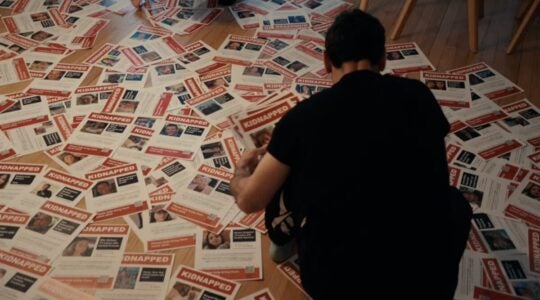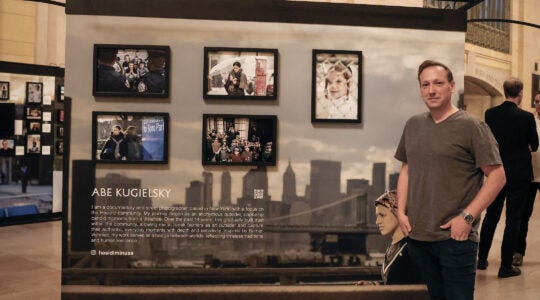NEW YORK (JTA) — It was love at first sight for Benny Roitman and Jon Ilani, a gay Jewish couple from New York. The two were set up by a friend, and while they seemed to hit it off from the start, their mutual interest grew once they learned they were both Israeli and had a traditional Jewish background.
Four years later, Benny and Jon are engaged and planning their wedding. Though they considered various ceremony options, having a Jewish wedding was important to them. So they turned to their rabbi, Rachel Weiss of New York’s gay synagogue, Congregation Beit Simchat Torah.
“In retrospect, we’re so happy we had a Jewish ceremony because our tradition is what brought us together in the first place,” Roitman told JTA. “Rabbi Weiss guided us through a beautiful ceremony where we were both signed our ketubah, wrapped ourselves in a tallit under the huppah [marriage canopy], and each broke a glass. It was really special to our families and there wasn’t a dry eye in the room.”
For a growing number of gay Jewish couples, marking their union in a Jewish way is both an imperative and a challenge. Until recently, the only Jewish ceremonial option was the traditional one joining a man and a woman.
But that’s beginning to change. Liberal rabbis have taken major strides in developing wedding customs — or adapting traditional ones — to fit the sensitivities of gay couples, from reworking the language of ketubahs, or marriage contracts, to varying the wording of the traditional blessings, to dropping certain elements, like the marriage canopy.
“A decade ago, most rabbis would not even agree to officiate at a gay wedding, let alone oversee a Jewish ceremony,” said Rabbi Victor Appell, who is working on a project to provide guidelines for gay ceremonies to members of the Central Conference of American Rabbis, the Reform movement’s rabbinic group. “But the community has had a shift in views, which is why more Jewish couples are deciding on a gay-friendly Jewish ceremony.”
Over the past decade, public support for gay marriage has risen dramatically in the United States, growing from less than 30 percent in the mid-1990s to just above 50 percent today, according to some polls. In May, President Obama expressed his support for gay marriage, which is legal in nine states.
In 2006, the Conservative movement’s authority on Jewish law, the Committee on Jewish Law and Standards, endorsed a legal opinion permitting gay clergy and gay commitment ceremonies. Rabbi Elliot Dorff, who co-authored the opinion, has since developed two ceremonies for same-sex Jewish weddings.
“We’ve found that there are two mind-sets within gay Jewish marriage,” Dorff said. “There are those that want to strictly follow the guidelines of a traditional ceremony, and then there are those that want something entirely different, sort of their own type of ceremony which differentiates the Jewish marriage symbol.”
One of Dorff’s ceremonies mirrors the traditional one: the couple stands under a huppah, seven blessings are recited, and one glass is broken. The second service alters the ceremony in fundamental ways: three blessings are recited, the huppah is optional and the ceremonial circling of the groom is split between the spouses.
Both versions do away with the kiddushin (literally, sanctification), in which a woman is “acquired” by her husband, a ritual considered to be the core of a traditional Jewish marriage.
Dorff also has penned a divorce document that shares financial responsibility between the spouses; in the traditional Jewish divorce, the man is responsible for the financial well-being of the woman.
“Gay couples want a sense of Jewish expression in their commitment to marriage,” Dorff said. “They deserve to feel connected to a long-standing community and generation.”
Other rabbis active on gay issues have taken a different approach, arguing that it’s important to retain the traditional elements of Jewish marriage. Rabbi Menachem Creditor of Congregation Netivot Shalom in Berkley, Calif., and co-founder of the gay-friendly group Keshet Rabbis, said he didn’t feel comfortable dropping kiddushin from gay marriage ceremonies.
“The idea is to sanctify a monogamous relationship, and gay marriage traditions should not be different from straight marriages,” Creditor said. “We should be looking at them in the same way.”
Rabbi Sharon Kleinbaum, the senior rabbi at CBST, has been officiating at gay Jewish marriages for nearly 30 years. Kleinbaum uses a huppah, recites seven blessings (with language appropriately modified to reflect the gender of the spouses) and performs a ring exchange. Her principal innovation was to revise the language of the marriage contract to speak of commitment and devotion rather than one spouse acquiring another.
“We allow the couple to change the English language of the sheva brachot [seven blessings] if they want to,” Kleinbaum said. “Often, couples will have seven family members or friends come up to the huppah and offer their own version of blessings after the sheva brachot. But gay ceremonies are basically the same as heterosexual ones.”
The Reform movement is working on a new version of its rabbi’s manual to include traditional and innovative guidelines for same-sex marriages. It marks the first time in the movement’s history that rabbis will have access to a written strategy on how to officiate a Jewish gay marriage.
“The same-sex marriage ceremonies were curated and edited by rabbis who have written the liturgy and used it over the years,” Appell said. “The rituals include a new ring ceremony, a different marriage contract to be sensitive to same genders, and an alternate translation of the sheva brachot, all of which were crafted in a unique and sensitive way.”
JTA has documented Jewish history in real-time for over a century. Keep our journalism strong by joining us in supporting independent, award-winning reporting.





